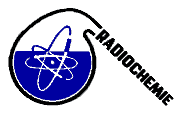Speaker
Dr
Myroslav Zoriy
(Reserch Center Jülich)
Description
Technetium is a one of product of nuclear fission of uranium and therefore could be found in a trace concentration in the Earth’s crust. It was estimated that a kilogram of uranium contains 1 nanogram (10−9 g) of technetium [1]. However, besides of naturally occurred Tc, in the last several decades its relatively high amount was artificially produced in the nuclear reactors by the thermal neutron fission of 235U and 239Pu reactor fuels with the fission yield product of 99Tc of about 6.1% [2]. The 99Tc has a half-life of 2.13*105 a, giving a specific activity of 650 MBq g-1 and decays by emission of beta-1 with Emax 300 keV. It has been released into the environment as the results of nuclear weapons testing and low- and intermediate-level waste disposal, and will be an important component of high level wastes when these are finally disposed [3]. Geochemically, Tc exists in two stable oxidation states depending on the redox conditions; it forms reduced species, predominantly Tc4+ and its complexes and compounds, however could also occurs as Tc (VII), which forms the pertechnetate anion, [TcO4-]. The environmental redox chemistry of technetium is thus very important in governing its mobility.
As a beta-emitter the 99Tc are determined with conventionally used low-level beta-counters. However, due to the often complicity of the analyzed samples (e.g. high concentrated salt samples) a separation procedure prior to the counting should be applied. In such case an internal standard should be applied in order to find out a chemical yield of the overall analyzing method. For the determination of recovery of 99Tc the short-lived isotope 99mTc (half-life: 6 hours) is usually applied that is sometimes unacceptable due to the rare availability, relatively high specific activity and low half-time and costs of metastable 99mTc.
In the present study we propose a new methodology for the assessment of the overall recovery of 99Tc determination by combining of the conventional beta-counting method with relatively fast inductively coupled plasma mass spectrometry (ICP-MS) measurements. The principle of the developed method is to use the naturally occurred Rhenium (as a homolog element to Technetium) as an internal standard in order to find out the losses of the analyte during of sample preparation procedure. The determination of Rhenium was performed by ICP-MS method and its recovery values were used for the correction of results for 99Tc measurements. The accuracies of Tc and Re recoveries observed by application of such approach were found to be in the range of 95-105%. After the recovery studies the developed procedure was applied for analysis of Tc activity in available standard solutions as well as in real samples: environmental (high concentrated salt samples) and biological (urine) samples. The results showed a good agreement of measured Technetium content with the predictable values and will be discussed during the presentation in details.
Primary author
Dr
Myroslav Zoriy
(Reserch Center Jülich)
Co-authors
M. Burow
(Reserch Center Jülich)
Dr
P. Hill
(Reserch Center Jülich)
P. Zoriy
(Reserch Center Jülich)
Dr
R Lennartz
(Reserch Center Jülich)
R. Flucht
(Reserch Center Jülich)

